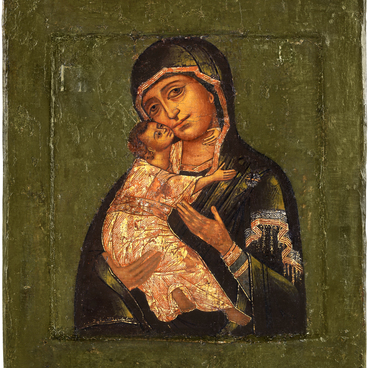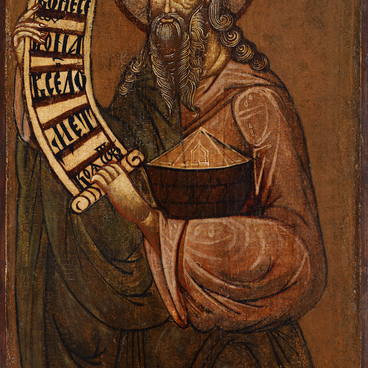On the icon from the collection of the Rybinsk Museum Reserve Nikolai the Wonderworker of Myrlikiya and Xenia Roman of Milyass are depicted together, although they lived and preached in different centuries.
Nicholas the Wonderworker was, in the IIIrd century, an archbishop in the city of Myra in the Roman province of Lycia. That time was marked by numerous persecutions of Christians — the Emperor Diocletian brutally cracked down on them. Nikolai of Myrlikiya also suffered for his faith: he was sent to prison, where he was tortured for a long time. The Saint got rescued in the 320s when Constantine the Great came to power making Christianity the main religion in the Empire. Saint Nicholas healed the sick with his prayers, saved the innocent from execution and once resurrected a drowned sailor.
The venerable Xenia of Rome was born in the 5th century AD. She was the daughter of a Roman senator, and, already in her youth, she decided to devote herself to serving God. When she was to be married off to a rich nobleman, she fled Rome disguised in male clothes. She founded a convent near the town of Milyass (in the territory of today’s Turkey), preaching and healing the sick throughout her life.
This icon was commissioned in 1755 for the wedding of noblepersons Nikolai Tishinin and Xenia Tarbeyeva, with their estate located near Rybinsk. Vassily Vasilevsky, the famous Moscow icon painter of the time, created the image. He painted icons for the Church of St. Symeon the God-Receiver and Anna the Prophetess as well as the Peter and Paul Cathedral in St. Petersburg. He also worked on frescoes in many Moscow churches, including the restoration of the paintings in the Assumption Cathedral of the Moscow Kremlin. Ten works, which are signed by the iconographer, have survived to this day, and the icon from the Rybinsk Museum Reserve is one of them.
Nicholas the Wonderworker was, in the IIIrd century, an archbishop in the city of Myra in the Roman province of Lycia. That time was marked by numerous persecutions of Christians — the Emperor Diocletian brutally cracked down on them. Nikolai of Myrlikiya also suffered for his faith: he was sent to prison, where he was tortured for a long time. The Saint got rescued in the 320s when Constantine the Great came to power making Christianity the main religion in the Empire. Saint Nicholas healed the sick with his prayers, saved the innocent from execution and once resurrected a drowned sailor.
The venerable Xenia of Rome was born in the 5th century AD. She was the daughter of a Roman senator, and, already in her youth, she decided to devote herself to serving God. When she was to be married off to a rich nobleman, she fled Rome disguised in male clothes. She founded a convent near the town of Milyass (in the territory of today’s Turkey), preaching and healing the sick throughout her life.
This icon was commissioned in 1755 for the wedding of noblepersons Nikolai Tishinin and Xenia Tarbeyeva, with their estate located near Rybinsk. Vassily Vasilevsky, the famous Moscow icon painter of the time, created the image. He painted icons for the Church of St. Symeon the God-Receiver and Anna the Prophetess as well as the Peter and Paul Cathedral in St. Petersburg. He also worked on frescoes in many Moscow churches, including the restoration of the paintings in the Assumption Cathedral of the Moscow Kremlin. Ten works, which are signed by the iconographer, have survived to this day, and the icon from the Rybinsk Museum Reserve is one of them.

